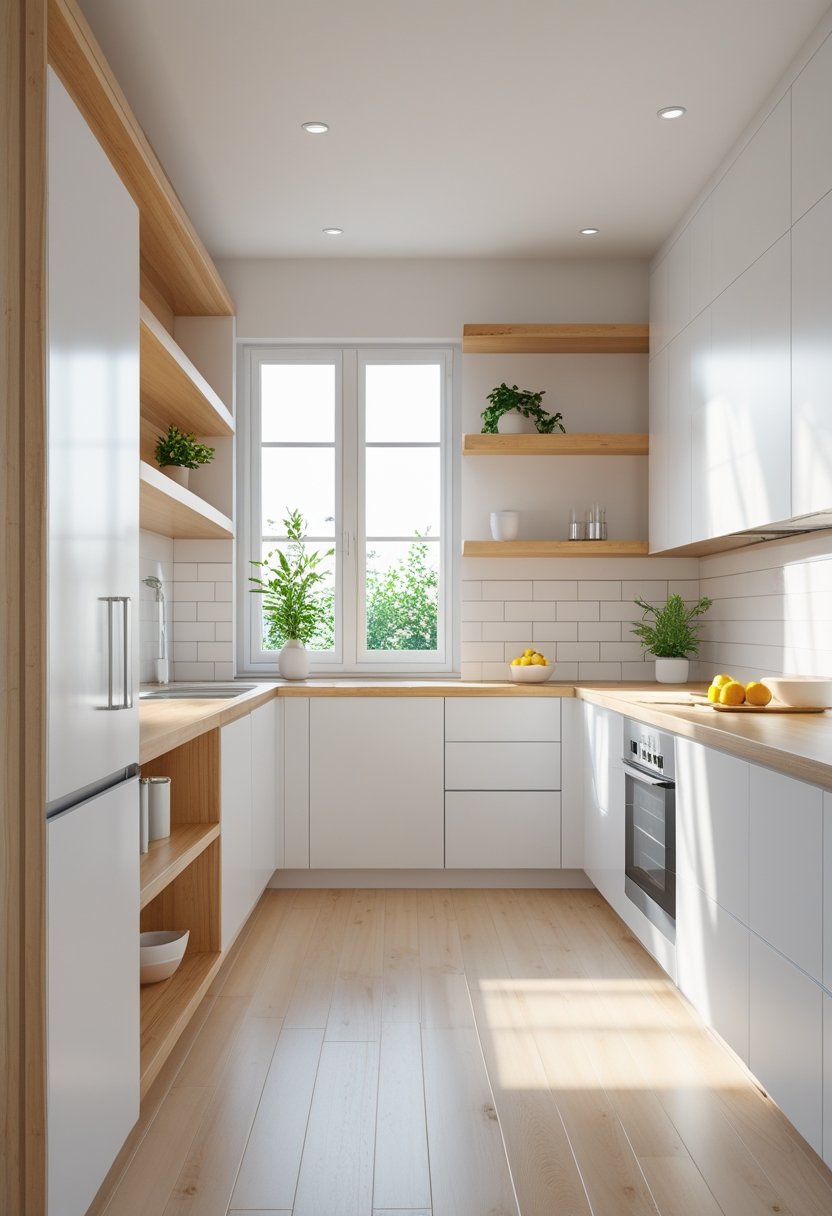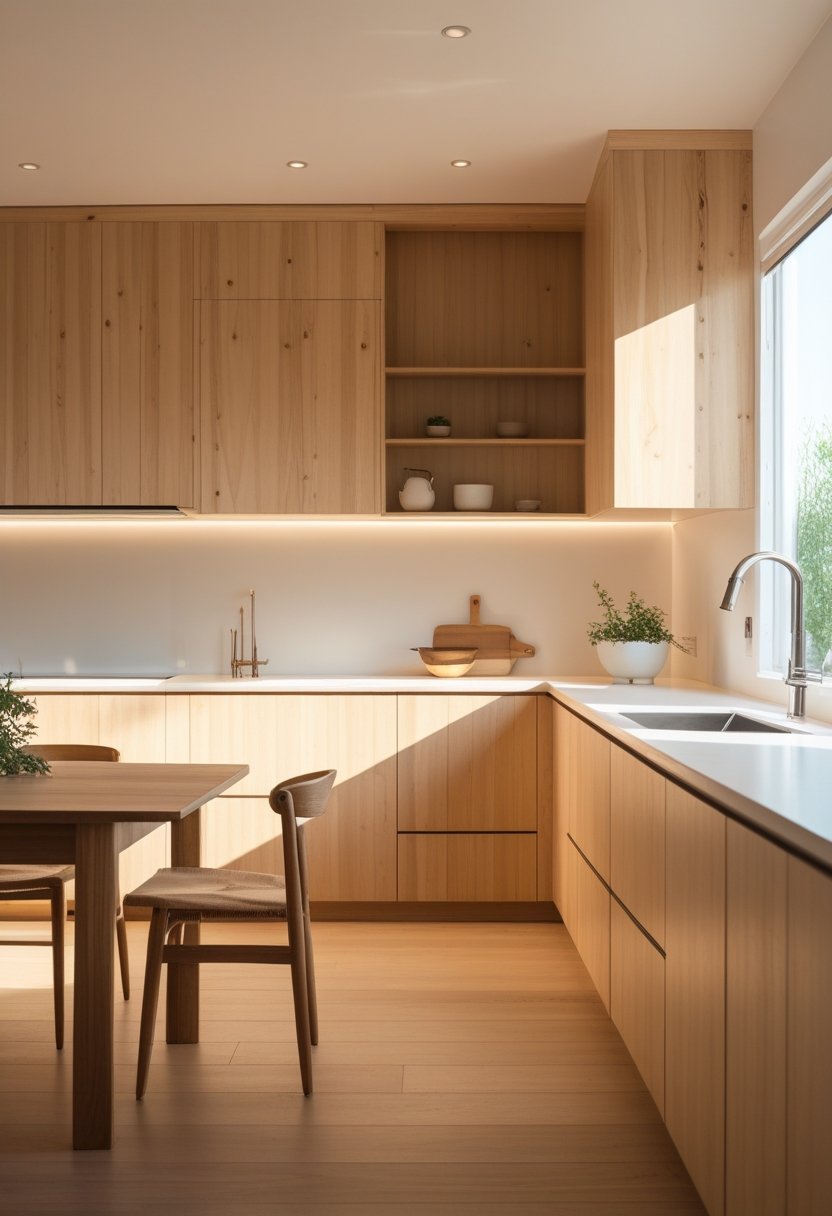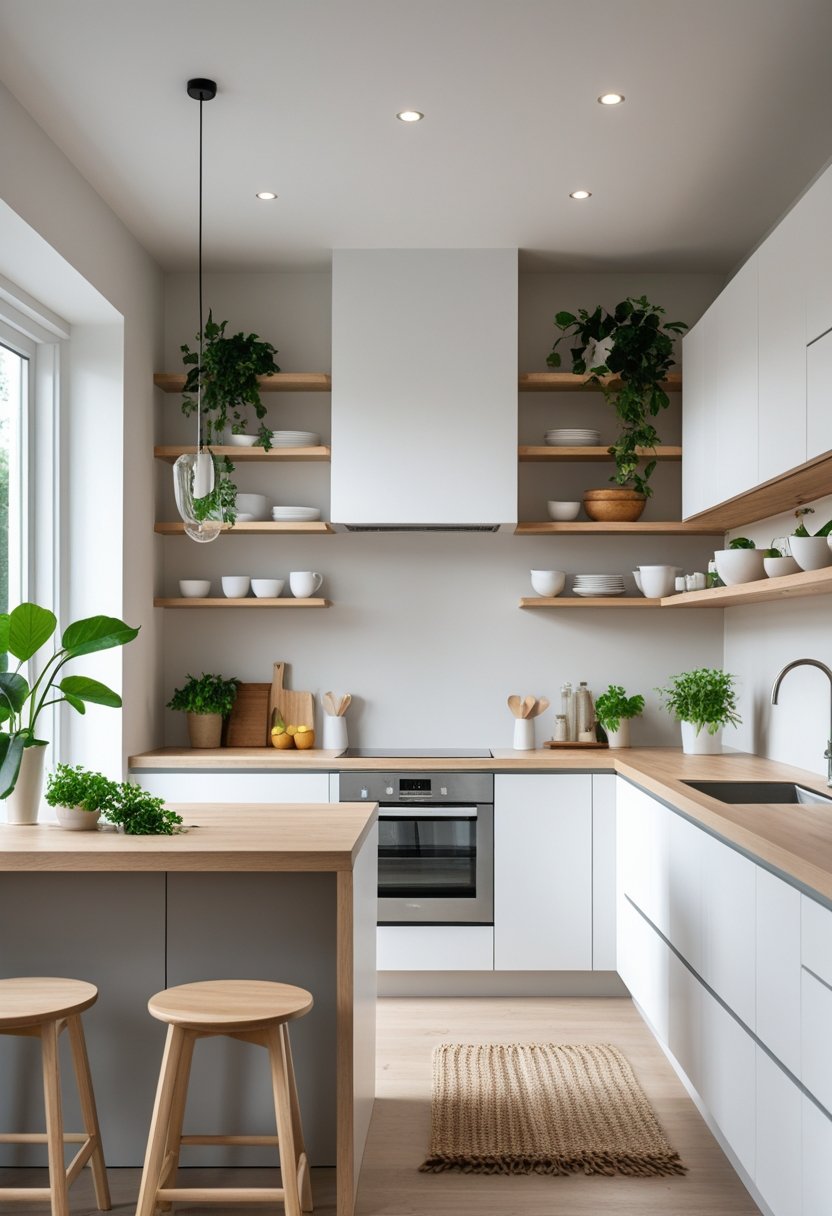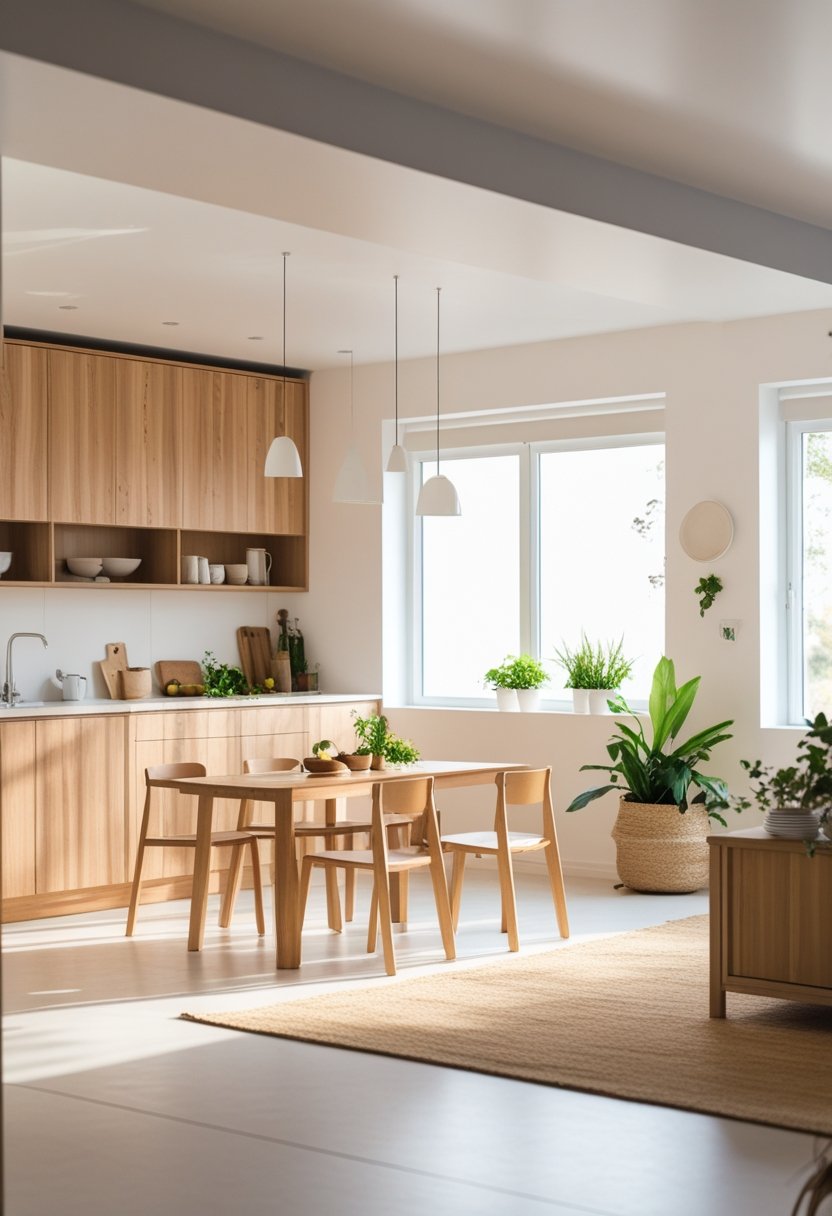Modern Scandinavian Kitchen Design: Minimal & Warm
This modern Scandinavian kitchen design expertly combines minimalist style with natural wood accents to create a warm and inviting atmosphere. The use of open shelving, sleek white cabinetry, and light wood countertops establishes a clean, airy look that balances style with functionality.

Accents such as indoor plants, boho-inspired decor, and pendant lighting bring an organic modern charm to the space, merging cozy elements with contemporary aesthetics. The kitchen island with bar stools encourages casual dining and socializing, making this layout ideal for both everyday use and entertaining.
The neutral color palette not only emphasizes timelessness but also reflects the growing trend toward sustainable home design in 2025. This kitchen demonstrates how thoughtful design choices can produce a space that feels both fresh and enduring.
Core Principles of Modern Scandinavian Kitchen Design

A modern Scandinavian kitchen relies on precise elements that create a balance of beauty and utility. It emphasizes thoughtful design choices that bring light, natural textures, and clear organization to the space without excess ornamentation.
Minimalist Design and Clean Lines
Minimalist design is central to modern Scandinavian kitchens. Clean lines define cabinetry, countertops, and shelving, eliminating visual clutter. This clarity creates a spacious, open feeling even in smaller kitchens.
The cabinetry typically features flat fronts with integrated handles or push-to-open mechanisms, contributing to an uninterrupted surface appearance. Open shelving often uses natural wood or metal, introducing texture while maintaining simplicity.
By prioritizing essential elements over decoration, minimalist design ensures the kitchen remains functional and easy to maintain. The result is a space that feels orderly and calm, aligning with Scandinavian minimalism principles.
Embracing Scandinavian Style
Scandinavian style embraces natural materials and a neutral color palette. Light woods, such as birch or ash, soften the modern aesthetic while enhancing warmth and tactile appeal.
White or light gray cabinetry is common, helping reflect natural light and keep the kitchen bright. Indoor plants and subtle boho-inspired décor add organic touches without disrupting the overall simplicity.
Lighting plays a key role too. Pendant lights with minimalist shapes or metal finishes complement the clean lines and natural tones, reinforcing the modern Scandi kitchen’s understated elegance.
Simplicity and Functionality
Functionality remains at the heart of Scandinavian kitchen design. Layouts focus on optimizing space and usability, with clear zones for cooking, prep, and dining.
Smart storage solutions, including open shelving and cleverly concealed cabinets, support easy access and organization without overcrowding. The kitchen island combines workspace with seating, encouraging social interaction during meal preparation.
This practical design avoids unnecessary features, ensuring every aspect serves a purpose. The style promotes sustainability by using durable materials and timeless design, sustaining appeal beyond trends.
Natural Materials and Warmth

The design emphasizes the use of elements that bring natural warmth and texture to the space. Carefully chosen materials contribute to both the aesthetic appeal and functional durability expected in modern kitchens. Emphasis on wood and stone highlights an organic feel that balances clean lines with inviting comfort.
Natural Wood Elements
Natural wood serves as a primary material in the kitchen’s design. Light wood flooring connects the space visually, creating continuity and a soft warm tone that contrasts well with sleek white cabinetry. Wood cabinetry and wooden countertops further enrich the kitchen, offering tactile warmth and a subtle grain pattern that adds depth without overwhelming the minimalist style.
The use of reclaimed or sustainably sourced wood enhances eco-conscious design goals. Different wood finishes—from matte to lightly polished—allow customization that suits various moods while maintaining durability. Wooden floorboards provide a resilient surface that complements the overall natural aesthetic.
Organic Textures and Finishes
Organic textures play a crucial role in creating a cozy atmosphere without compromising minimalism. Surfaces like light-grain cabinetry balance smooth, clean lines with subtle natural imperfections that add character. The tactile quality of these materials invites touch and visual interest.
Finishes tend to be matte or satin, avoiding gloss to emphasize authenticity and reduce glare. This choice maintains a soft visual presence while providing practical resistance to stains and wear. Textural accents, such as woven baskets or ceramic pots, help underline the natural theme and soften the space further.
Stone and Marble Countertops
Stone countertops offer an ideal combination of elegance and practicality. Marble countertops are particularly effective in this design, contributing both a classic but understated visual element and a durable work surface. The natural veining of marble adds subtle movement and pattern to balance the solid wood components.
Other stone materials, like quartz or granite with natural finishes, are used to maintain the organic feel while providing resistance to scratches and heat. Stone countertops contrast nicely with wooden surfaces, creating a layered look that enhances the kitchen’s timeless and sustainable design.
Essential Features for a Scandinavian Kitchen

A Scandinavian kitchen often focuses on simplicity and efficiency without sacrificing style. Key components include crisp white surfaces, accessible storage solutions, and a palette that promotes light and openness. These elements create a space that is functional, inviting, and visually balanced.
White Cabinetry and Countertops
White cabinetry is foundational in defining the Scandinavian kitchen. It promotes brightness and amplifies natural light, making the space feel more expansive and clean.
White cabinets provide a versatile backdrop that pairs well with natural wood accents and other textures. They are often matte or satin finished to reduce glare and add subtle warmth.
Countertops in white quartz or similar materials maintain a seamless, smooth surface that supports the minimalist aesthetic. They resist stains and scratches, contributing to practical upkeep.
Including a white backsplash enhances the uniformity and simplicity of the design, keeping focus on the kitchen’s light and airy character.
Open and Floating Shelving
Open shelving is a key feature, offering both display and easy access to everyday items. Floating shelves contribute to a sense of space by avoiding visual bulk.
These shelves typically use light wood or painted finishes to blend with the cabinetry and walls. Displaying dishware, glassware, or simple decor adds personality without clutter.
Open shelving encourages organization since items remain visible. It reinforces the Scandinavian principle of functional beauty, combining practicality with style.
Neutral and Light Color Palettes
Neutral palettes center on whites, soft greys, and gentle beiges to cultivate a calm and balanced environment. Light color schemes help reflect natural light throughout the kitchen.
This approach contrasts clean surfaces with natural wood tones, adding warmth and texture to the space. It creates an inviting atmosphere without overwhelming simplicity.
Using muted colors ensures longevity in design, making the kitchen adaptable to seasonal decor or evolving tastes. It supports the sustainable and timeless qualities valued in Scandinavian interiors.
Layout, Lighting, and Functional Zones

This modern Scandinavian kitchen balances open space with thoughtfully arranged functional areas. Its design maximizes usability through a clear layout, smart lighting choices, and designated zones for cooking, dining, and storage.
Kitchen Island with Bar Stools
The kitchen island serves as a central hub for preparation, dining, and socializing. With a light wood countertop that complements the cabinetry, the island offers ample workspace and storage underneath.
Bar stools around the island create an informal dining area that encourages interaction during cooking. Their minimalist design and neutral tones align with the kitchen’s overall aesthetic.
The island’s positioning often allows for easy movement between the sink, stove, and refrigerator, enhancing workflow. It also doubles as a gathering spot, making the kitchen versatile for both everyday tasks and entertaining.
Light Fixtures and Pendant Lights
Pendant lights are strategically placed above the kitchen island to provide focused task lighting. These fixtures blend sleek metal or muted ceramic materials with simple geometric shapes.
The design incorporates adjustable brightness to suit various activities, from meal prep to relaxed evening gatherings. Pendant lights help define the island area visually while maintaining the kitchen’s open feel.
Additional light fixtures, such as recessed ceiling lights, ensure even illumination across work surfaces without cluttering the design. Lighting choices emphasize functionality without sacrificing the minimalist style valued in Scandinavian interiors.
Optimizing Natural Light
Floor-to-ceiling windows or large windows bring abundant natural light into the kitchen, which is crucial for both atmosphere and energy efficiency. Light-colored walls and reflective surfaces enhance this brightness, making the space feel larger and more inviting.
Placement of the kitchen layout respects the path of sunlight, positioning work zones in well-lit areas. Window treatments, when used, are kept minimal to avoid blocking daylight.
Natural light not only improves visibility for cooking tasks but also highlights the natural wood textures and neutral tones central to Scandinavian design.
Smart Storage Solutions
Storage is integrated seamlessly to maintain the kitchen’s clean and uncluttered appearance. Cabinets and drawers are designed with soft-close mechanisms to reduce noise and wear.
Open shelving is used selectively to display attractive kitchenware or décor, contributing to the room’s personalized and airy atmosphere. Pull-out organizers and vertical storage systems optimize the use of available space.
The design prioritizes accessibility, ensuring frequently used items are within easy reach. This combination of hidden and open storage balances practicality with the minimalist look.
Decor and Accents for Modern Scandinavian Charm

This kitchen design uses carefully chosen elements to reinforce its minimalist and natural wood theme. Contrasting details, organic textures, and cultural influences work together to create a balanced, inviting environment. Strategic choices in plants, hardware, and decorative objects emphasize both warmth and function.
Indoor Plants and Greenery
Potted plants play a vital role in introducing life and color into Scandinavian kitchens. They soften the clean lines of cabinetry and open shelving, adding a natural texture that complements light wood countertops. Popular choices include small ferns, succulents, and herbs placed in simple ceramic or terracotta containers.
Greenery also enhances air quality and contributes to the kitchen’s overall sense of calm. Positioning plants near windows maximizes natural light exposure, while trailing varieties on upper shelves add vertical interest. These subtle touches increase Nordic charm by referencing nature and sustainable living.
Black Accents and Hardware
Black accents provide visual contrast against the white and light wood palette, grounding the space while maintaining elegance. Elements like black pendant lights over the island, matte black faucets, and black countertop edges draw the eye without overwhelming the minimalist aesthetic.
Hardware such as cabinet handles and drawer pulls in black metal add a modern industrial edge. This choice also improves durability and ease of maintenance. Together, these black details harmonize functionality and style, reinforcing the kitchen’s sleek, contemporary look.
Boho and Hygge-Inspired Accessories
Boho-inspired decor introduces warmth and personality through textiles and curated objects. Items like woven baskets, patterned rugs, and linen napkins bring softness to the hard surfaces. These accessories promote hygge—a Danish concept centered on comfort and coziness—making the kitchen inviting.
Decorative elements such as handmade ceramics, wooden bowls, and subtle patterns create visual interest without cluttering the space. Layered textiles and earthy tones complement the natural wood accents, enhancing the kitchen’s organic modern ambiance while maintaining practicality.
Rustic and Japandi Influences
Rustic charm appears through reclaimed timber accents and rough-hewn textures, adding depth to the clean modern lines. Japandi style, a blend of Japanese simplicity and Scandinavian minimalism, introduces smooth, functional design choices focused on calm and balance.
Features like simple wooden stools, bamboo trays, and ceramic tableware reflect this fusion. Natural materials and muted colors dominate, supporting a lifestyle centered on mindfulness and intentional living. The blend of rustic and Japandi influences strengthens the kitchen’s timeless and sustainable design ethos.
Timeless Appeal: Sustainability and Longevity

This kitchen design prioritizes materials and elements that stand the test of time while supporting eco-friendly living. The use of durable finishes, thoughtful design choices, and classic color palettes contributes to both sustainability and long-term relevance.
Durability of Materials
The kitchen features light wood cabinetry known for its strength and resilience, ideal for high-use areas. Materials like stainless steel appliances add to durability, resisting corrosion and wear.
Cabinet styles such as shaker-style or handleless cabinets promote longevity by avoiding fast trends and sticking to clean lines that age well. Quality wood and hardware ensure the kitchen maintains its function and appearance over years of daily use without needing frequent replacement.
Durability extends to surfaces like light wood countertops that balance sturdiness with natural aesthetics. Proper maintenance of these materials also preserves their integrity, reducing waste and contributing to sustainable home design.
Sustainable Design Practices
Sustainability in this kitchen comes from choices that minimize environmental impact throughout its lifecycle. The selection of reclaimed or responsibly sourced wood reflects eco-conscious decisions.
Using open shelving instead of bulky upper cabinets reduces material consumption while improving light flow. Energy-efficient stainless steel appliances lower electricity use, aligning with green home principles.
The layout encourages multi-functionality, reducing the need for excess furniture or fixtures. This adaptability supports sustainable living by optimizing space and resource use. Overall, the design avoids excessive ornamentation and emphasizes quality over quantity.
Timeless Color Schemes
A neutral color palette anchors the kitchen’s timeless look, featuring whites and light wood tones that remain stylish beyond seasonal trends. These colors create a bright, inviting atmosphere while complementing natural light.
This restrained use of color allows for easy updates through accessories like plants or lighting without the need for costly renovations. It also enhances visual harmony when combined with natural textures, such as wood and metal finishes.
By focusing on simplicity in hue and contrast, the color scheme sustains aesthetic appeal for years, supporting both the kitchen’s functional and design longevity.
Creating an Inviting and Cozy Gathering Space

This kitchen design emphasizes both practicality and warmth, centering on elements that encourage social interaction and comfort. Natural materials and flexible seating options make it suitable for various activities, from daily meals to larger gatherings.
Casual Dining and Entertaining
The kitchen island with wooden stools serves as a focal point for casual dining and informal entertaining. It provides a versatile space where family members can eat breakfast, chat, or help prepare meals without feeling confined to a formal dining room.
A wooden dining table nearby supports more structured family gatherings, offering ample space for shared meals. Its natural wood finish adds warmth and contrasts with the sleek cabinetry. Together, these seating arrangements create a fluid environment that adapts to different occasions.
Blending Style with Comfort
This design balances minimalist aesthetics with cozy accents to prevent the space from feeling sterile. Light wood countertops and cabinetry maintain an airy, open atmosphere, while textured wooden stools introduce a tactile, homey element.
Pendant lighting with warm tones enhances the ambience, making evenings inviting without overpowering the clean design. The overall look stays modern but incorporates comfort through thoughtful material choices and lighting that highlight the kitchen’s organic features.
Incorporating Personal Touches
Adding indoor plants brings life and natural color, breaking the monochrome palette subtly yet effectively. Boho-inspired decor elements, such as woven baskets or textured fabrics, inject personality without cluttering the space.
These personal touches reflect a lived-in feel and encourage a welcoming environment. Together with the natural wood features, they emphasize sustainability and timeless style, aligning with current design trends focused on durable and meaningful home elements.

Ana Luisa
Explore in-depth biographies, net worth insights, and exclusive updates on your favorite singers at Trionua.com. Discover the journeys, achievements, and latest news about music’s biggest stars.






